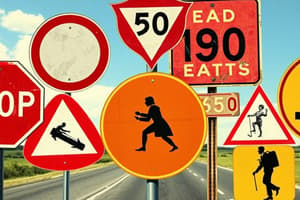Podcast
Questions and Answers
What is the meaning of an octagon sign?
What is the meaning of an octagon sign?
- Yield
- No Passing
- Warning
- Stop (correct)
What color is used for warning signs?
What color is used for warning signs?
- Green
- Yellow (correct)
- Blue
- Red
What should you do at a STOP sign?
What should you do at a STOP sign?
Come to a complete stop and yield the right of way.
What actions should you take when approaching a flashing yellow signal?
What actions should you take when approaching a flashing yellow signal?
What are five situations where warning signs might be used?
What are five situations where warning signs might be used?
What is the difference between broken yellow lines and broken white lines?
What is the difference between broken yellow lines and broken white lines?
What types of special roadway markings exist?
What types of special roadway markings exist?
What is the purpose of guide signs?
What is the purpose of guide signs?
What actions should you take at a green light?
What actions should you take at a green light?
Match the signal colors with their meanings:
Match the signal colors with their meanings:
Flashcards are hidden until you start studying
Study Notes
Sign Shapes and Their Meanings
- Octagon indicates a stop.
- Triangle symbolizes yield.
- Vertical rectangle represents regulatory signs.
- Pentagon denotes school zones.
- Round shape signals a railroad crossing.
- Pennant warns of no passing zones.
- Diamond shape indicates warnings.
- Horizontal rectangle serves as a guide.
Traffic Sign Colors and Their Meanings
- Red denotes stop, yield, or prohibited actions.
- Yellow serves as a warning to drivers.
- White represents regulatory information.
- Orange indicates construction or detours.
- Black is used for regulatory signs.
- Green guides to various routes and directions.
- Blue signifies motorist services.
- Brown points to public recreation areas.
Actions at Traffic Signs
- At a STOP sign, come to a complete halt and yield to pedestrians and other vehicles.
- At a YIELD sign, slow down or stop, yielding right of way to cross traffic.
- Speed limit signs inform drivers of the maximum or minimum safe speed.
Warning Signs Situations
- Warning signs may be used for no passing zones.
- Indicate railroad crossings.
- Mark school zones and sharp curves.
- Alert drivers to upcoming intersections.
- Signal potential animal crossings.
Role of Guide and International Signs
- Guide signs indicate routes, intersections, services, and points of interest.
- International signs utilize symbols instead of text, making them universally recognizable.
Traffic Light Protocols
- At a red light, stop completely behind lines or crosswalks.
- Make every reasonable effort to stop at a yellow light.
- Proceed through a green light only if the intersection is clear of traffic.
Actions for Flashing Signals
- At a flashing red signal, come to a complete stop.
- Slow down and prepare to stop at a flashing yellow signal, proceed with caution as stopping is not required.
Pedestrian Signals and Traffic Control Officers
- The WALK signal is for pedestrians, coinciding with a green light for drivers in the same direction.
- The DON'T WALK signal usually precedes the appearance of a yellow light.
- Traffic control officers use a hand signal: a raised hand for stop and a wave for go.
Differences in Roadway Lines
- Broken yellow lines separate two-way traffic.
- Broken white lines distinguish lanes in the same direction.
Shared Left Turn Lane vs. Left Turn Lane
- Shared left turn lanes enable safer mid-block turns for drivers in both directions.
- A designated left turn lane is meant for turning left at intersections only.
Special Roadway Markings
- No parking zones indicate prohibited parking areas.
- Handicapped parking spaces are specially marked.
- Yellow or white markings indicate obstacles on the roadway.
- Railroad crossing markings alert drivers of train tracks.
- White markings show where exit ramps begin.
- Rumble strips warn drivers to slow down for hazards.
Studying That Suits You
Use AI to generate personalized quizzes and flashcards to suit your learning preferences.




